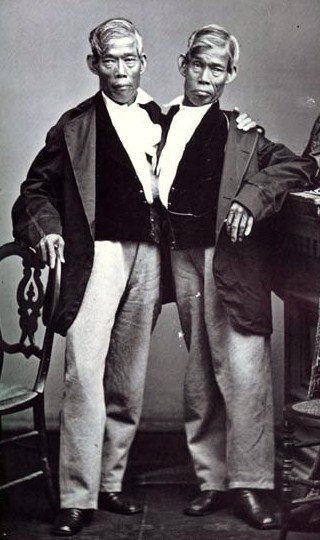Eng Bunker (Eng Bunker)

Entertainers. Born in the Mae Klong Valley, Samut Songkhram Province, Siam (present day Thailand) to a Chinese father, Ti-aye and a Chinese/Cham mother, Nok. The brothers, Eng and Chang Bunker, were born conjoined thoraopagus twins, the most common form of conjoined twins, they shared part of the chest wall, and their livers were fused. Legend relates that their mother worked the flesh and cartilage that linked the brothers until it stretched enough so that they might stand side by side instead of eternally face to face. Initially under sentence of death as evil omens, King Rama III vacated the decree, and at the age of 16, the brothers were presented to the King. In 1824, Scottish merchant Robert Hunter discovered the twins and asked the Siamese government for permission to take the boys from the country. After long delay, permission was granted in 1829 and the twins were exhibited as a curiosity during a successful world tour. They terminated association with their promoters after a dispute over money and in 1832 promoted themselves, and spent a tenure with P. T. Barnum. In 1839 they retired from the exhibition circuit and settled in Wilkesboro, North Carolina where they became American citizens, listed as ‘Chang and Eng, Siamese Twins.’ It wasn’t until some years later when they adopted the name of Bunker. In April 1843, they married sisters Adelaide and Sarah Anne Yates in a double wedding. For several years the two couples shared a home, but after a falling out between the sisters which embroiled the brothers as well, separate households were established and the brothers spent the rest of their lives on a three day cycle moving back and forth between homes. Eventually Chang fathered 10 children and Eng 11. During the Civil War, each saw a grandson serve the Confederacy, and they lost much of their property at war’s end including their slaves, and became quite bitter. Chang reportedly took refuge in drink, Eng in gambling even as they returned to the exhibit circuit to support their families, each taking one of their children who also performed in their show. They joined the Barnum American Museum, but never matched their previous success. In 1870 during a transatlantic voyage, Chang was stricken by a debilitating stroke, and was paralyzed along the right side of his body forcing his brother to be his physical support. In January 1874, Chang contracted a severe case of bronchitis which, in his weakened condition, contributed to his death; either late on the 16th or in the early morning of the 17th. Apparently Eng woke to find his brother dead, called for his wife and children and refused a plea to be separated from his brother. He died some three hours later. An autopsy indicated that Chang died due to a blood clot in the brain; and Eng’s death was attributed to shock. The Bunkers were notable as the first widely known conjoined twins, to the point that conjoined twins were called ‘Siamese’ for decades to come. Historically, the overall survival rate of conjoined twins was less than 25% and over the past 500 years less than 30% of those surviving pairs were male. Mark Twain’s short story “The Siamese Twins” used the brothers as its basis. (bio by: Iola) Family links: Parents: Ti-aye (1780 – 1830) Nok (1791 – 1825) Spouse: Sarah Ann Yates Bunker (1822 – 1892) Children: Katherine Marcellus Bunker (1844 – 1871)* Julia Ann Bunker (1845 – 1865)* Stephen Decatur Bunker (1846 – 1920)* James Montgomery Bunker (1848 – 1921)* Patrick Henry Bunker (1850 – 1938)* Rosalyn Etta Bunker (1852 – 1852)* William Oliver Bunker (1855 – 1932)* Frederick Marshall Bunker (1857 – 1886)* Rosella Virginia Bunker Ashby (1859 – 1941)* Georgianna Columbia Bunker (1863 – 1865)* Robert Edward Bunker (1865 – 1951)* Sibling: Chang Bunker (1811 – 1874)* Eng Bunker (1811 – 1874) *Calculated relationship
Born
- May, 11, 1811
- Thailand
Died
- January, 01, 1874
- USA
Cemetery
- White Plains Baptist Church Cemetery
- USA

